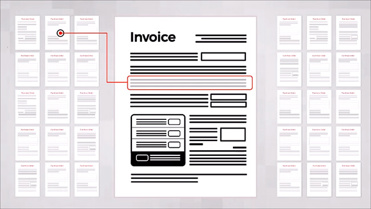What is invoice matching?
Invoice matching involves comparing and linking a supplier invoice with the underlying data on which the cost is based – a purchase order and goods delivery receipt (GDR), or a contract.


Invoice matching involves comparing and linking a supplier invoice with the underlying data on which the cost is based – a purchase order and goods delivery receipt (GDR), or a contract.
Invoice matching is a key step in the accounts payable (AP) workflow that verifies the accuracy of incoming invoices by comparing them with related documents such as purchase orders (POs), goods delivery receipts (GDRs), or contracts.
It ensures that what is billed matches what was ordered and received, helping to reduce payment errors, prevent fraud, and enforce internal controls. This process helps reduce errors, improve financial control, and support compliance efforts while also laying the groundwork for automation and efficiency in AP operations. It also plays a vital role in maintaining financial transparency by creating a clear audit trail for every transaction, helping businesses strengthen internal controls, prepare for audits, and ensure alignment with budgeting and compliance policies.
As AP teams look to modernize workflows and adopt touchless invoice processing, invoice matching becomes a foundational capability—particularly within broader invoice automation, e-invoicing, and invoice capture strategies.
Manually matching invoices to purchase orders (PO) and goods delivery receipts (GDR) is complex and time-consuming. Especially when it requires matching invoices to purchase orders at the line level. In complex cases one invoice may include goods or services for all purchases done over a month's period, hence bundling multiple purchase orders from different buyers within the organization. Accounts payable is then tasked with tracing down which invoice item corresponds to which purchase order.
A digital accounts payable (AP) automation solution can manage the invoice matching process through a fully automated workflow that operates without manual intervention. With an intelligent matching engine using AI and machine learning technology, today’s AP platforms—particularly those designed with intelligent invoice capture and automation in mind—can handle even the most complex matching scenarios and help save valuable time for the accounts payable team. These innovations are often part of larger e-invoicing ecosystems that streamline compliance and support end-to-end AP automation.

When the information on the invoice does not match the underlying data from the PO, GDR or contract, a deviation (or exception) occurs. This deviation must be reviewed and handled by the person within the organization who is responsible for the purchase in question. In many cases, this can be a complex and tedious task.
Accounts payable software that leverages AI and automation can simplify and streamline the exception-handling process by automatically identifying deviations and sending only the specific invoice lines to the right person for review and decision.
This adaptive logic is especially important as companies scale their AP functions and seek to maintain both compliance and efficiency in increasingly complex workflows.
Automated invoice matching is a foundational function in accounts payable automation. The process compares incoming invoices with supporting documents—such as purchase orders, delivery receipts, or inspection approvals—to ensure accuracy before payments are processed. The level of invoice matching used depends on the company’s internal controls, risk appetite, and industry-specific requirements, especially as organizations look to streamline operations through a touchless invoice workflow.

Two-way matching compares the supplier’s invoice to the original purchase order. This approach confirms that the quantities, pricing, and terms listed on the invoice match what was agreed upon when the order was placed.
It’s typically used for straightforward, low-risk purchases where goods or services are consistent and predictable—such as recurring office supplies or standard service contracts.
While two-way matching is faster and less complex, it leaves more room for error since it does not confirm that the goods were actually received. Businesses using two-way matching should implement additional controls or audits if vendor performance or fulfillment issues arise.
Three-way matching adds a critical layer of verification by ensuring that the invoice matches both the purchase order and the goods delivery receipt (GDR). This helps confirm that the products or services have actually been delivered before payment is made.
Three-way matching is the most common approach in industries like manufacturing, logistics, and retail, where validating the full delivery of goods is essential. It significantly reduces the risk of overpayments, duplicate payments, or fraud by requiring alignment across all key purchasing documents.
Many companies weighing two-way versus three-way invoice matching adopt the latter as part of broader AP automation best practices that enhance accuracy and control.


Four-way matching includes all the steps of three-way matching, with one additional check: the invoice is also compared against an inspection or acceptance document that confirms the quality or condition of the goods received.
This approach is most common in industries with stringent compliance, safety, or quality assurance standards—such as pharmaceuticals, aerospace, and construction—where materials may need to pass a formal inspection before payment is authorized.
Four-way matching creates a highly controlled payment environment. By verifying that the PO, receipt, invoice, and inspection all align, it minimizes financial risk and ensures regulatory and contractual compliance. Beyond compliance, organizations are also using advanced matching strategies to drive greater AP workflow efficiency and touchless processing at scale.
Modern invoice matching has evolved from basic automation into a smarter, more adaptive process. Medius uses artificial intelligence and machine learning to move beyond traditional rule-based systems. By learning from past transactions, recognizing patterns, and applying contextual insights, the platform continuously improves accuracy and reduces exceptions throughout the invoice lifecycle.
Complex multi-line invoices are auto-matched to multiple POs or deliveries — even across departments or entities.
The system adapts to vendor behavior, recognizing common pricing fluctuations or rounding differences and reducing manual exceptions.
Invoice deviations are intelligently routed to the right stakeholder with all necessary context for resolution.
Matching accuracy improves continuously as the system "learns" from every decision made across your team.
This means fewer delays, faster approvals, and more touchless processing—helping finance teams move from reactive exception handling to proactive optimization.
These intelligent workflows are especially impactful when integrated with invoice capture technologies and automated processing layers across the full AP cycle.

Ready to reduce exceptions, eliminate manual matching, and increase AP efficiency? Let’s talk about how Medius can help you streamline invoice processing with intelligent automation.
Inefficient invoice matching can delay payments, affect early payment discounts, and increase the risk of duplicate or erroneous payments. This disrupts cash flow forecasting and can harm supplier relationships. By automating the process, businesses can maintain accurate payment schedules, better manage working capital, and ensure full visibility into liabilities before payments are made—especially when integrated within a holistic invoice automation solution.
Beyond just automation, leaders should assess the system’s flexibility to handle multi-PO invoices, support for 2-way/3-way/4-way matching, integration with existing ERPs, and AI capabilities for handling exceptions. It's also critical to consider ease of use, vendor onboarding, and reporting tools for compliance and audit readiness.
Invoice matching acts as a frontline defense against payment fraud. By requiring alignment between the invoice, PO, and goods receipt before payment approval, it helps detect discrepancies that could indicate fraudulent activity, such as fake vendors or duplicate billing. Advanced solutions also flag outliers or suspicious patterns using AI—adding another layer of control within highly regulated or high-volume AP environments.
Yes. Not all purchases involve physical goods. In cases where services are procured, 2-way matching (invoice to PO) or contract-based matching can be used. Medius supports flexible workflows that adapt to both product and service-based purchasing—ensuring accuracy regardless of the nature of the transaction and aligning with strategies for e-invoicing beyond compliance.